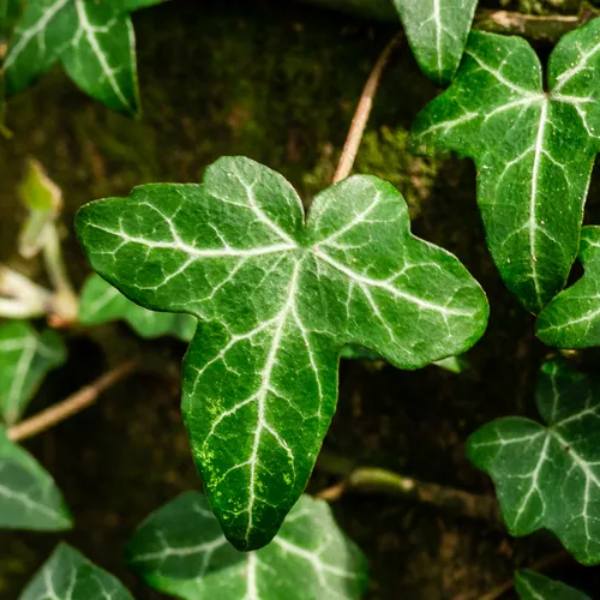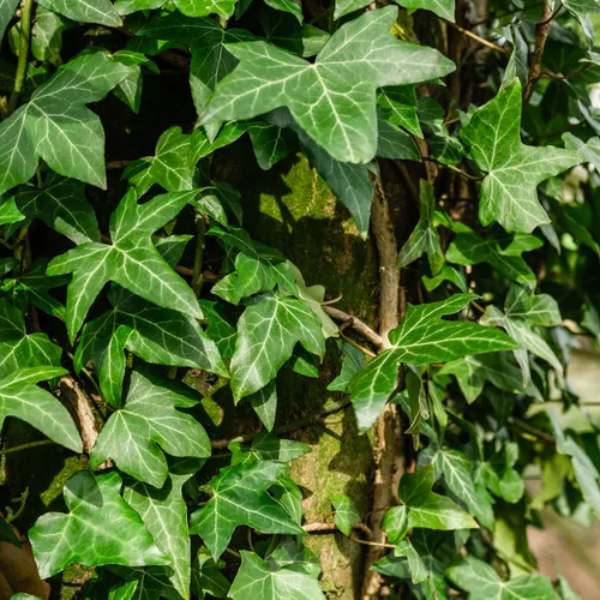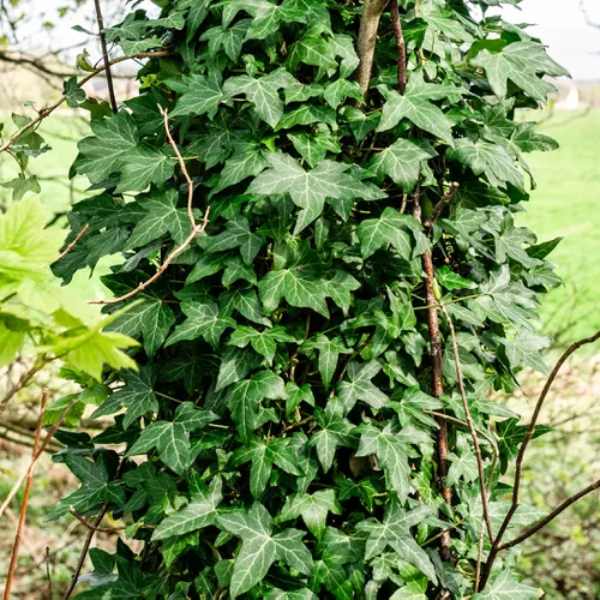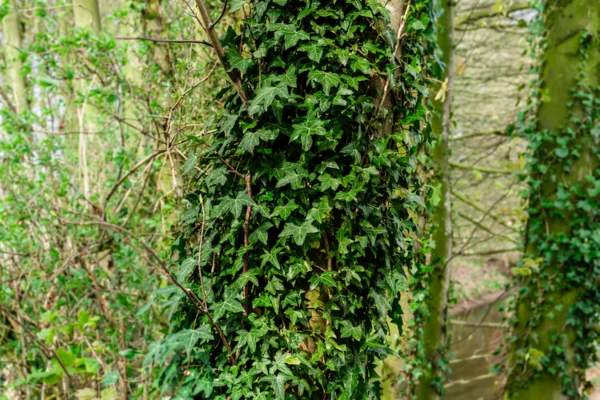English ivy (Hedera helix) is an evergreen perennial that is classified as a woody vine. This wonderful plant can act as a ground cover, spreading horizontally. But it is a climber since it has aerial roots which allows it to climb 80 feet.
This plant bears insignificant greenish flowers too but people normally grow them for their evergreen leaves. That is the reason why Ivy can be considered a foliage plant. Spring is the best time to plant English Ivy. Because of its fast, aggressive growing nature, this plant is considered invasive in many areas. Do not allow your kids and pets to eat these plants because they are toxic.
Plant Attributes
- Common Name: English ivy, common ivy, European ivy
- Botanical Name: Hedera helix
- Family: Araliaceae
- Plant Type: Perennial, evergreen climbing vine
- Mature Size: N/A; climbs and spreads as much as possible
- Sun Exposure: Part shade to full shade
- Soil Type: Fertile and moist
- Soil pH: Neutral to slightly alkaline
- Bloom Time: Fall
- Flower Color: Greenish-white, greenish-yellow
- Hardiness Zones: 4-13 (USDA)
- Native Area: Europe, Scandinavia, Russia
- Toxicity: Toxic to people and pets
How to care for English Ivy?
Here are the main requirements for growing English Ivy:
- Plant in well-drained soil in partial to full shade.
- The soil should be a bit dry but still moist.
- Give the plant a 20-20-20 fertilizer every two weeks during spring and summer.
- English Ivy spreads quickly and is great as a ground cover for filling in hard-to-plant spots in your landscaping.
Warning
English Ivy is known to be invasive in many areas, including the Pacific Northwest, California, several Southeast states, and parts of the Midwest. Before planting one, talk to a local extension office to confirm that it is not considered an invasive species in your area. This plant also might cause damage to brickwork and even trees.

Light
English Ivy grows better in partial shade to full shade. Since it thrives in shade, it has become a traditional ground cover for planting under trees, where most grasses may not do that well. If you’re thinking of an effective ground cover that crowds out weeds, English Ivy is the one because of its dense growth habit.
If you grow them indoors, they need bright, indirect light in summer but also can do well from some direct sunlight in winter.
Soil
This evergreen vine will thrive in well-drained soil. While it can survive in poor soils and soils with different ranges of pH levels, it is the happiest in average loams. A thick layer of mulch is good for keeping the soil moist in dry climates. Indoors, this plant thrives in a potting mix that is loose and well-drained.
Water
Always check your soil before adding water to your ivy. They prefer to live better on the dry side so let the soil dry out a bit before you water your ivy plants again. Indoor or outdoor ivy love moist soil but they despise soggy soil. Also, ensure that the plant gets enough drainage. Ivy hates standing water or overly wet soil.
Temperature and Humidity
English Ivy thrives in temperatures between 70 and 90 degrees Fahrenheit. When grown in steady temperatures and medium to high humidity, their leaves will become dark green. However, ivy doesn’t stand cold winter wind or extreme summer heat.
In many areas, some species of ivy can survive winter even if potted outdoors, and new growth is seen from the stems in spring.
Fertilizer
Give English ivy a 20-20-20 fertilizer (or a 2-2-2 organic formula) every two weeks in spring and summer. Avoid using fertilizer or plant food if the plant is in a stressful situation: very hot, very cold, or very dry soil, or when leaf production has stopped.
Pruning
When it comes to pruning, do it using clean and sharp cutting shears to trim ground cover plants in the spring as that helps them stay manageable and discourage bacterial leaf spot. Try pruning an ivy into a bushy shape by pinching off its growing tips in spring when it is most active. A proper pruning every year revitalizes the plant.

If your Ivy has already started climbing up one of your trees, you have to be careful if you want to remove it. If you rip a vine off, it will hurt the tree’s bark. Instead, cut each vine that is coming out of the soil at the base of the tree, where it is based. If you find the spot from where it is growing and cut that off, the part that is left on the vine will eventually wither and die.
This is the best technique to get rid of the plant naturally. However, it requires some patience. You will need to repeat the process year after year and cut new growth until all strength has been taken out of the plant. Only then, the new shoots will stop growing every spring.
Also, Read What Is a Perennial? How to Choose and Care for Perennial Plants!
Overwintering
You need to protect English ivy from winds. Prepare the soil by keeping it moist throughout the fall and before the first frost arrives. If the soil is moist and the foliage is dry, it will help English Ivy survive the colder seasons.
Propagating English Ivy
The same trimmings or stem cuttings from your pruning will help propagate new plants. Just follow these simple steps:
- Take healthy stems that are 4 to 5 inches long. Dip the cut ends in water and wait for the roots to grow.
- After the roots have developed, transfer the stems to a pot or the ground. If grown on grounds, they naturally spread when the stem comes in contact with the soil and takes root. You can also cut rooted stems and dig them up to move them to a container or a different location in your garden.
Potting and Repotting English Ivy
Some gardeners enjoy growing these plants in hanging baskets and let them cascade over the sides. Considering their invasive quality, this is a sensible way of growing the vines without worrying that they will spread out of hand.
Small ivy plants can be repotted once a year while the bigger ones can be repotted every two years. While repotting, always use new potting soil to make sure it gets enough nutrition. Older plants can often be revived by just replacing the soil in the same container.
Common Pests and Plant Diseases
English Ivy may attract insects like aphids, spider mites, mealybugs, and other pests which you can take care of by just spraying off with water. They can be controlled by neem oil or insecticidal soap. You can create a homemade remedy with a mixture of dish soap and water to prevent aphids.
Diseases that affect ivy are bacterial soap and root rot. Black or dark brown leaf spot appears on the plant foliage. Unfortunately, the only remedy is to remove the affected plants. If any plants are remaining, protect them by spraying them with a 10-to-1 mixture of water and vinegar.

Root rot normally happens due to warm and humid weather and can be deadly to affected plants. Here also, removal of the infected part is the only best remedy. Rest of the remaining plants can be protected with fungicide.
FAQs
Q: Is English Ivy easy to care for?
A: Outdoors, English ivy needs little to no care for it to thrive. Indoors, you’ll need to pay a bit more attention to the plant.
Q: How fast does English ivy grow?
A: Since English ivy is aggressive, it can grow rapidly. It establishes quickly outdoors (within months). English ivy grows slower indoors and can take at least a year to establish itself before it has a growth spurt.
Q: Can English ivy grow indoors?
A: English ivy can be grown indoors, where it thrives with relatively cool nights and frequent misting to maintain humidity. However, it is generally considered to be a finicky houseplant, despite its being a common offering at garden centers.
Q: What are the best non-toxic alternatives to English ivy?
A: Native vines such as Virginia Creeper and Golden Ragwort are beneficial plants to wildlife and are nontoxic. American wisteria and Dutchman’s pipe, although deciduous, are also good alternatives to English Ivy.
Also, Read Low maintenance Garden border Ideas || Best plants for garden edges
